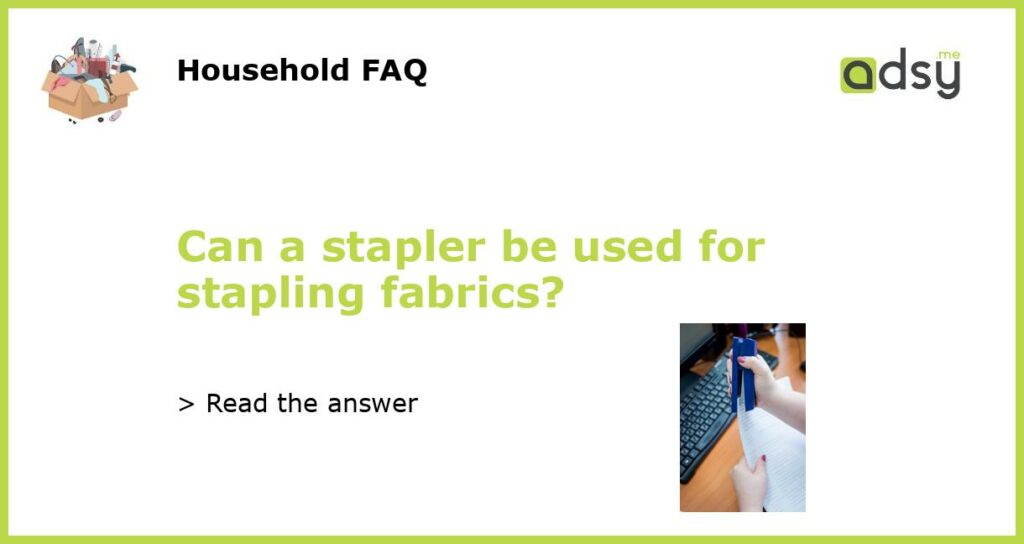Yes, a stapler can be used for stapling fabrics
When it comes to stapling, most people automatically think of paper and office supplies. However, a stapler can also be a convenient tool for fastening fabrics. Whether you are working on a sewing project or need a quick fix for a loose hem, a stapler can provide a simple and effective solution. In this article, we will explore the different ways you can use a stapler for stapling fabrics and discuss some tips for achieving the best results.
Hemming and repairs
A common use for a stapler when it comes to fabrics is hemming. If you need to shorten the length of a pair of pants or a skirt, a stapler can provide a temporary solution until you have access to a sewing machine or can stitch the hem by hand. Simply fold the fabric to the desired length, hold it in place, and staple along the edge. This can be a quick and effective way to achieve the desired length without the need for sewing.
Additionally, a stapler can be used for small repairs on fabrics. If you have a small tear or a loose seam, a well-placed staple can provide a temporary fix until you can properly mend the fabric. This can be especially useful in emergency situations or when you do not have access to sewing supplies.
Crafting and upholstery projects
Stapling can also be a handy technique for various crafting and upholstery projects. Whether you are upholstering a chair, creating decorative fabric wall art, or making fabric-covered storage boxes, a stapler can be a useful tool for securing the fabric in place. It provides a quick and secure way to attach the fabric to the desired surface without the need for sewing or glue.
When working on upholstery projects, it is essential to use a heavy-duty stapler or a staple gun to ensure that the staples penetrate the fabric and the material beneath it. Regular office staplers may not have enough power to securely fasten the fabric, especially if it is thicker or more substantial, such as upholstery fabric.
Temporary fixes and mock-ups
If you are testing out an idea or need a temporary fix, a stapler can be a great tool. For example, if you are draping fabric for a garment or need to hold fabric in place while you make adjustments, stapling can provide a quick and easy solution. The staples can easily be removed or replaced with proper stitching once you have finalized your design or have access to sewing supplies.
Additionally, stapling can be useful for creating mock-ups or prototypes. If you are working on a project and want to test the positioning or fit of fabric pieces before committing to sewing, stapling can be a valuable technique. It allows you to make adjustments quickly and easily without the need for time-consuming sewing or seam ripping.
Tips for using a stapler on fabrics
When using a stapler for stapling fabrics, there are a few tips that can help you achieve the best results:
- Choose the right stapler: As mentioned earlier, it is important to use a heavy-duty stapler or a staple gun when working with fabrics, especially thicker or more substantial materials. Regular office staplers may not have enough power to adequately fasten the fabric.
- Test on scrap fabric: Before stapling your main fabric, it is always a good idea to test the stapler on a scrap piece of similar material. This allows you to determine the optimal staple depth and avoid any potential damage or puckering of the fabric.
- Position the staples strategically: When stapling fabrics, it is crucial to position the staples strategically to ensure they are not visible in the final project. Consider hiding the staples in seams, folds, or areas that will be covered or hidden by other components.
- Remove or cover the staples: If you have used a stapler as a temporary fix or for testing purposes, remember to remove the staples once you no longer need them. Leaving staples in fabric for extended periods can create permanent damage. Alternatively, if the staples are not easily removable, consider covering them with decorative elements or other fabric to hide their presence.
- Use caution with delicate or fragile fabrics: While a stapler can be a convenient tool for fabrics, it may not be suitable for delicate or fragile materials. Thinner or delicate fabrics may tear or pucker when stapled, so it is important to exercise caution and consider alternative methods, such as hand stitching or fabric glue, for these types of fabrics.
In conclusion, a stapler can be used for stapling fabrics in various situations. Whether you are hemming garments, working on crafting or upholstery projects, creating mock-ups, or in need of a temporary fix, a stapler can provide a quick and convenient solution. It is important to choose the right type of stapler, position the staples strategically, and exercise caution when working with delicate fabrics. By following these tips, you can achieve great results when using a stapler for stapling fabrics.






